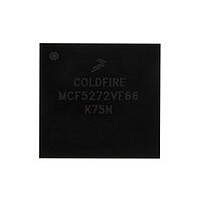MCF5272VF66 Freescale, MCF5272VF66 Datasheet - Page 94

MCF5272VF66
Manufacturer Part Number
MCF5272VF66
Description
Manufacturer
Freescale
Datasheet
1.MCF5272VF66.pdf
(544 pages)
Specifications of MCF5272VF66
Family Name
MCF5xxx
Device Core
ColdFire
Device Core Size
32b
Frequency (max)
66MHz
Instruction Set Architecture
RISC
Supply Voltage 1 (typ)
3.3V
Operating Temp Range
0C to 70C
Operating Temperature Classification
Commercial
Mounting
Surface Mount
Pin Count
196
Package Type
MA-BGA
Lead Free Status / RoHS Status
Not Compliant
Available stocks
Company
Part Number
Manufacturer
Quantity
Price
Company:
Part Number:
MCF5272VF66
Manufacturer:
HYNIX
Quantity:
19
Company:
Part Number:
MCF5272VF66
Manufacturer:
FREESCAL
Quantity:
885
Company:
Part Number:
MCF5272VF66
Manufacturer:
Freescale Semiconductor
Quantity:
10 000
Part Number:
MCF5272VF66
Manufacturer:
FREESCALE
Quantity:
20 000
Company:
Part Number:
MCF5272VF66J
Manufacturer:
Freescale
Quantity:
256
Company:
Part Number:
MCF5272VF66J
Manufacturer:
Freescale Semiconductor
Quantity:
10 000
Company:
Part Number:
MCF5272VF66R2
Manufacturer:
Freescale Semiconductor
Quantity:
10 000
Company:
Part Number:
MCF5272VF66R2J
Manufacturer:
Freescale Semiconductor
Quantity:
10 000
- Current page: 94 of 544
- Download datasheet (7Mb)
ColdFire Core
ColdFire processors support a 1024-byte vector table aligned on any 1-Mbyte address boundary; see
Table
remaining 192 are user-defined interrupt vectors.
2-26
3. The processor saves the current context by creating an exception stack frame on the system stack.
4. The processor acquires the address of the first instruction of the exception handler. The exception
2-18. The table contains 256 exception vectors where the first 64 are defined by Freescale; the
ColdFire processors support a single stack pointer in the A7 address register; therefore, there is no
notion of separate supervisor and user stack pointers. As a result, the exception stack frame is
created at a 0-modulo-4 address on the top of the current system stack. Additionally, the processor
uses a simplified fixed-length stack frame for all exceptions. The exception type determines
whether the program counter in the exception stack frame defines the address of the faulting
instruction (fault) or of the next instruction to be executed (next).
vector table is aligned on a 1-Mbyte boundary. This instruction address is obtained by fetching a
value from the table at the address defined in the vector base register. The index into the exception
table is calculated as 4 x vector_number. When the index value is generated, the vector table
contents determine the address of the first instruction of the desired handler. After the fetch of the
first opcode of the handler is initiated, exception processing terminates and normal instruction
processing continues in the handler.
Numbers
Vector
16–23
25–31
32–47
48–60
6–7
10
11
12
13
14
15
24
0
1
2
3
4
5
8
9
MCF5272 ColdFire
Vector Offset
080–0BC
018–01C
040–05C
064–07C
0C0–0F0
(Hex)
00C
02C
03C
000
004
008
010
014
020
024
028
030
034
038
060
Table 2-18. Exception Vector Assignments
®
Program Counter
Integrated Microprocessor User’s Manual, Rev. 3
Stacked
Fault
Fault
Fault
Fault
Fault
Fault
Fault
Fault
Next
Next
Next
Next
Next
Next
—
—
—
—
—
—
1
Initial stack pointer
Initial program counter
Access error
Address error
Illegal instruction
Divide by zero
Reserved
Privilege violation
Trace
Unimplemented line-a opcode
Unimplemented line-f opcode
Debug interrupt
Reserved
Format error
Uninitialized interrupt
Reserved
Spurious interrupt
Level 1–7 autovectored interrupts
Trap #0–15 instructions
Reserved
Assignment
Freescale Semiconductor
Related parts for MCF5272VF66
Image
Part Number
Description
Manufacturer
Datasheet
Request
R
Part Number:
Description:
Mcf5272 Coldfire Integrated Microprocessor User
Manufacturer:
Freescale Semiconductor, Inc
Datasheet:

Part Number:
Description:
MCF5272 Interrupt Service Routine for the Physical Layer Interface Controller
Manufacturer:
Freescale Semiconductor / Motorola
Datasheet:

Part Number:
Description:
TOWER ELEVATOR BOARDS HARDWARE
Manufacturer:
Freescale Semiconductor
Datasheet:

Part Number:
Description:
TOWER SERIAL I/O HARDWARE
Manufacturer:
Freescale Semiconductor
Datasheet:

Part Number:
Description:
LCD MODULE FOR TWR SYSTEM
Manufacturer:
Freescale Semiconductor
Datasheet:

Part Number:
Description:
DAUGHTER LCD WVGA I.MX51
Manufacturer:
Freescale Semiconductor
Datasheet:

Part Number:
Description:
TOWER SYSTEM BOARD MPC5125
Manufacturer:
Freescale Semiconductor
Datasheet:

Part Number:
Description:
KIT EVALUATION I.MX51
Manufacturer:
Freescale Semiconductor
Datasheet:

Part Number:
Description:
KIT DEVELOPMENT WINCE IMX25
Manufacturer:
Freescale Semiconductor
Datasheet:

Part Number:
Description:
TOWER SYSTEM KIT MPC5125
Manufacturer:
Freescale Semiconductor
Datasheet:

Part Number:
Description:
TOWER SYSTEM BOARD K40X256
Manufacturer:
Freescale Semiconductor
Datasheet:

Part Number:
Description:
TOWER SYSTEM KIT K40X256
Manufacturer:
Freescale Semiconductor
Datasheet:

Part Number:
Description:
Microcontrollers (MCU) MX28 PLATFORM DEV KIT
Manufacturer:
Freescale Semiconductor
Datasheet:

Part Number:
Description:
MCU, MPU & DSP Development Tools IAR KickStart Kit for Kinetis K60
Manufacturer:
Freescale Semiconductor
Datasheet:

Part Number:
Description:
24BIT HDMI MX535/08
Manufacturer:
Freescale Semiconductor
Datasheet:











